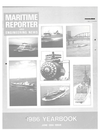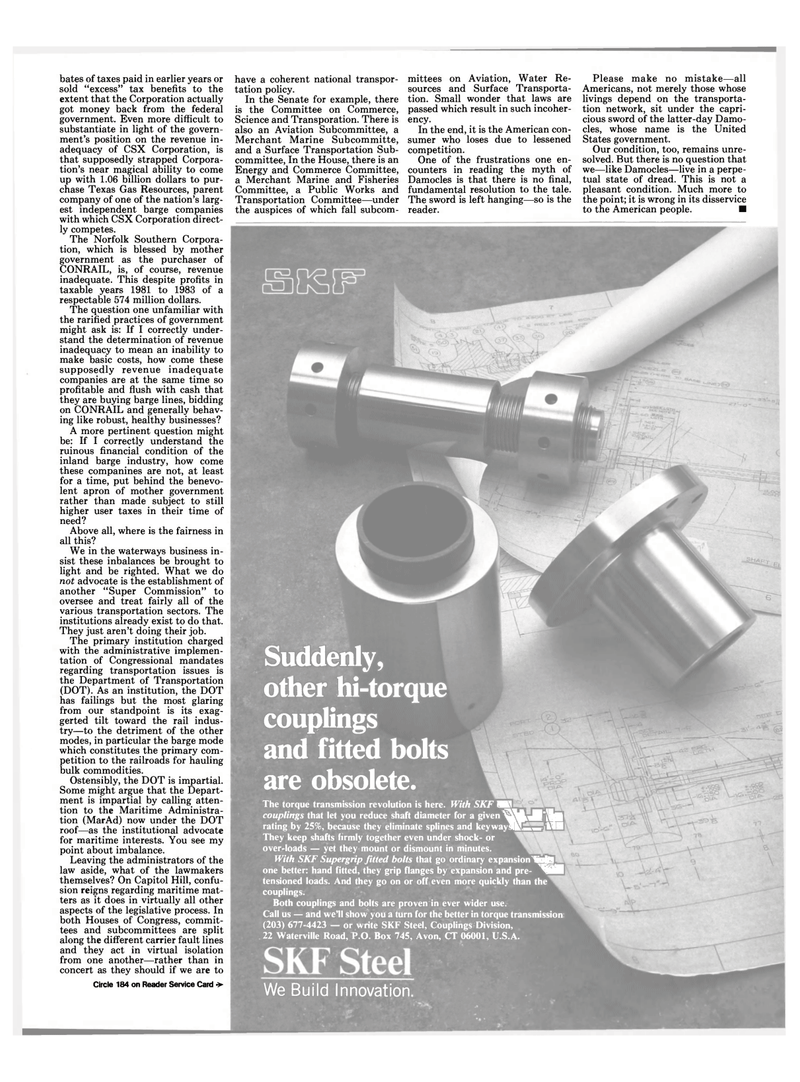
Page 47: of Maritime Reporter Magazine (June 1986)
Read this page in Pdf, Flash or Html5 edition of June 1986 Maritime Reporter Magazine
bates of taxes paid in earlier years or sold "excess" tax benefits to the extent that the Corporation actually got money back from the federal government. Even more difficult to substantiate in light of the govern- ment's position on the revenue in- adequacy of CSX Corporation, is that supposedly strapped Corpora- tion's near magical ability to come up with 1.06 billion dollars to pur- chase Texas Gas Resources, parent company of one of the nation's larg- est independent barge companies with which CSX Corporation direct- ly competes.
The Norfolk Southern Corpora- tion, which is blessed by mother government as the purchaser of
CONRAIL, is, of course, revenue inadequate. This despite profits in taxable years 1981 to 1983 of a respectable 574 million dollars.
The question one unfamiliar with the rarified practices of government might ask is: If I correctly under- stand the determination of revenue inadequacy to mean an inability to make basic costs, how come these supposedly revenue inadequate companies are at the same time so profitable and flush with cash that they are buying barge lines, bidding on CONRAIL and generally behav- ing like robust, healthy businesses?
A more pertinent question might be: If I correctly understand the ruinous financial condition of the inland barge industry, how come these companines are not, at least for a time, put behind the benevo- lent apron of mother government rather than made subject to still higher user taxes in their time of need?
Above all, where is the fairness in all this?
We in the waterways business in- sist these inbalances be brought to light and be righted. What we do not advocate is the establishment of another "Super Commission" to oversee and treat fairly all of the various transportation sectors. The institutions already exist to do that.
They just aren't doing their job.
The primary institution charged with the administrative implemen- tation of Congressional mandates regarding transportation issues is the Department of Transportation (DOT). As an institution, the DOT has failings but the most glaring from our standpoint is its exag- gerted tilt toward the rail indus- try—to the detriment of the other modes, in particular the barge mode which constitutes the primary com- petition to the railroads for hauling bulk commodities.
Ostensibly, the DOT is impartial.
Some might argue that the Depart- ment is impartial by calling atten- tion to the Maritime Administra- tion (MarAd) now under the DOT roof—as the institutional advocate for maritime interests. You see my point about imbalance.
Leaving the administrators of the law aside, what of the lawmakers themselves? On Capitol Hill, confu- sion reigns regarding maritime mat- ters as it does in virtually all other aspects of the legislative process. In both Houses of Congress, commit- tees and subcommittees are split along the different carrier fault lines and they act in virtual isolation from one another—rather than in concert as they should if we are to
Circle 184 on Reader Service Card •> have a coherent national transpor- tation policy.
In the Senate for example, there is the Committee on Commerce,
Science and Transporation. There is also an Aviation Subcommittee, a
Merchant Marine Subcommitte, and a Surface Transportation Sub- committee, In the House, there is an
Energy and Commerce Committee, a Merchant Marine and Fisheries
Committee, a Public Works and
Transportation Committee—under the auspices of which fall subcom- mittees on Aviation, Water Re- sources and Surface Transporta- tion. Small wonder that laws are passed which result in such incoher- ency.
In the end, it is the American con- sumer who loses due to lessened competition.
One of the frustrations one en- counters in reading the myth of
Damocles is that there is no final, fundamental resolution to the tale.
The sword is left hanging—so is the reader.
Please make no mistake—all
Americans, not merely those whose livings depend on the transporta- tion network, sit under the capri- cious sword of the latter-day Damo- cles, whose name is the United
States government.
Our condition, too, remains unre- solved. But there is no question that we—like Damocles—live in a perpe- tual state of dread. This is not a pleasant condition. Much more to the point; it is wrong in its disservice to the American people. •
Suddenly, other hi-torque couplings and fitted bolts are obsolete.
The torque transmission revolution is here. With SKF OK couplings that let you reduce shaft diameter for a given '^S^raff" |jp rating by 25%, because they eliminate splines and key way! , •" 3
They keep shafts firmly together even under shock- or over-loads — yet they mount or dismount in minutes.
With SKF Supergrip fitted bolts that go ordinary expansion boitS one better: hand fitted, they grip flanges by expansion and pre- ^SH tensioned loads. And they go on or off even more quickly than the couplings.
Both couplings and bolts are proven in ever wider use.
Call us — and well show you a turn for the better in torque transmission: (203) 677-4423 — or write SKF Steel, Couplings Division, 22 Waterville Road, P.O. Box 745, Avon, CT 06001, U.S.A.
We Build Innovation

 46
46

 48
48
